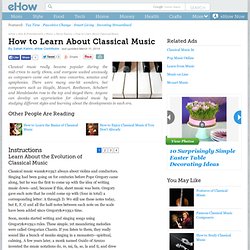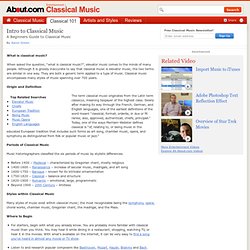

"Listening to Western Music" Sixth Edition by Craig Wright with Accompanying CDs. Historia de la Música (Lecciones Ilustradas) ¿Introducción a la Música Clásica. Probablemente para empezar con la musica académica te ayude escuchar algo intermedio (composiciones clasicas en el mundo del rock).

Mi compositor favorito es Bach, tambien fue el primero que escuche (hace ya algunos años) asi que sugerire algunas en version rock, y tambien algunas piezas en su version original: Badinerie de la Segunda Suite Orquestal: Version de Yngwie Malmsteen: Version original: Air de la Tercera Suite Orquestal Yngwie: Version Original: Double Concerto in Dm Guitarra electrica Version Original Bueno, es dificil decirte piezas porque hay tantas tan buenas que es complicadisimo escoger. Vivaldi: Las cuatro estaciones Bach: Los conciertos de Brandemburgo Tocatta y Fuga en re menor BWV 565 Suites para Cello Mozart: Eine Kleine Nachtmusik Sinfonias 40, 35 y 25 Sonata Facile Rondo Alla Turca Beethoven: Sonatas para piano Sinfonias No 4 y 9 Brahms: Danzas Hungaras Rossini: Overturas y asi vas empezando.
How to Learn About Classical Music. Classical music wasn't always about violins and conductors.

Singing had been going on for centuries before Pope Gregory came along, but he was the first to come up with the idea of writing music down--and, because if this, sheet music was born. Gregory gave each note that he could come up with (four in total) a corresponding letter: A through D. We still use these notes today, but E, F, G and all the half-notes between each note on the scale have been added since Gregory's time. Soon, monks started writing and singing songs using Gregory's rules. These simple, yet meandering melodies were called Gregorian Chants. During an age when visual art and religious beliefs were being reborn, music was not about to be left out. The Baroque Era emerged around the late 1600s, it was fashionable for the royalty and rich households to employ a composer (sort of like a maid or a chauffeur). Music History 102. A Guide to Western Composers and their Music from the Middle Ages to the Present CONTENTS of Music History 102: As is usual with information on the history of Western music, this site has been organized according to the eras of history: The Middle Ages After the collapse of the Roman Empire in the 5th century AD, Western Europe entered a time known as "The Dark Ages" — a period when invading hordes of Vandals, Huns, and Visigoths overran Europe.

These years were marked by constant warfare, the absence of a Holy Roman Emperor, and the virtual disappearance of urban life. The Renaissance Generally considered to be from ca.1420 to 1600, the Renaissance (which literally means "rebirth") was a time of great cultural awakening and a flowering of the arts, letters, and sciences throughout Europe. The Baroque Age The Classical Period At this time the Austrian capital of Vienna became the musical center of Europe, and works of the period are often referred to as being in the Viennese style.
Ariama.com - Classical music CDs, MP3s, and lossless audio. Intro to Classical Music. What is classical music?

When asked the question, “what is classical music?” , elevator music comes to the minds of many people. Although it is grossly inaccurate to say that classical music is elevator music, the two terms are similar in one way. They are both a generic term applied to a type of music. Classical music encompasses many styles of music spanning over 700 years. Origin and Definition The term classical music originates from the Latin term classicus, meaning taxpayer of the highest class. Periods of Classical Music Music historiographers classified the six periods of music by stylistic differences.
Before 1400 – Medieval – characterized by Gregorian chant, mostly religious 1400-1600 – Renaissance – increase of secular music, madrigals, and art song 1600-1750 – Baroque – known for its intricate ornamentation 1750-1820 – Classical – balance and structure 1820-1900 – Romantic – emotional, large, programmatic Beyond 1900 – 20th Century – limitless. Lecture 1 - Introduction.